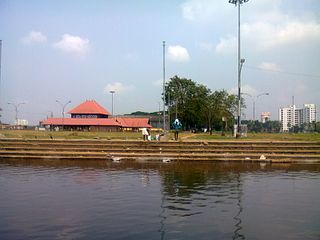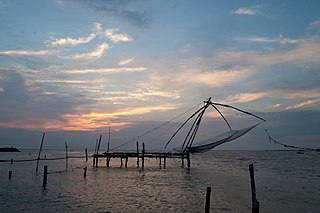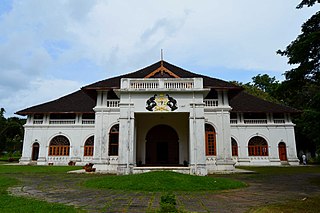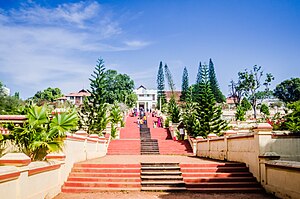
Kochi, also known by its former name Cochin, is a major port city along the Malabar Coast of India bordering the Laccadive Sea. It is part of the district of Ernakulam in the state of Kerala. The city is also commonly referred to as Ernakulam. As of 2011, the Kochi Municipal Corporation had a population of 677,381 over an area of 94.88 km2, and the larger Kochi urban agglomeration had over 2.1 million inhabitants within an area of 440 km2, making it the largest and the most populous metropolitan area in Kerala. Kochi city is also part of the Greater Cochin development region and is classified as a Tier-II city by the Government of India. The civic body that governs the city is the Kochi Municipal Corporation, which was constituted in the year 1967, and the statutory bodies that oversee its development are the Greater Cochin Development Authority (GCDA) and the Goshree Islands Development Authority (GIDA).

Ernakulam is one of the 14 districts in the Indian state of Kerala, and takes its name from the eponymous city division in Kochi. It is situated in the central part of the state, spans an area of about 2,924 square kilometres (1,129 sq mi), and is home to over 9% of Kerala's population. Its headquarters are located at Kakkanad. The district includes Kochi, also known as the commercial capital of Kerala, which is famous for its ancient churches, Hindu temples, synagogues and mosques.

The kingdom of Cochin, also known as the kingdom of Kochi or later as Kochi state or Cochin state, named after its capital in the city of Kochi (Cochin), was a kingdom in the central part of present-day Kerala state. It commenced at the early part of the 12th century and continued to rule until its accession to the Dominion of India in 1949.
Paliath Achan or Paliyath Achan is the name given to the male members of the Paliam family, a Nair/Menon royal family from the Indian state of Kerala who ruled over Chendamangalam, Vypin, parts of Thrissur and regions that were under the erstwhile Kingdom of Villarvattom. The family had palaces and forts in these regions but their primary residence remained in Chendamangalam. The Paliath Achans were given the role of hereditary Prime ministership of the Kingdom of Cochin by the Kochi Maharajah.

Aluva, is a municipality in the Ernakulam district of Kerala, India. It is part of the Kochi metropolitan area, 15 km (9.3 mi) north of the Kochi city centre. As per the 2011 Indian census, Aluva has a population of 22,428.

Thrippunithura, also spelled Tripunithura,, is a municipality in the Ernakulam district of Kerala, India. It is part of the Kochi metropolitan area, 7 km (4.3 mi) east of the Kochi city centre. As per the 2011 Indian census, Thrippunithura has a population of 69,390. A prominent historical region, Thrippunithura was the capital of the erstwhile Kingdom of Cochin. The Hill Palace situated in Thripunithura was the palace of Maharaja of Cochin, the ruler of Kingdom of Cochin. Thrippunithura is known for its rich culture which includes the annual Vrishchikotsavam festival that takes place at the Sree Poornathrayeesa Temple.

Rama Varma Kunji Pillai Thampuran (1751–1805), or Rama Varma IX, popularly known as Sakthan Thampuran, was the ruler of the Kingdom of Cochin. The current southern Indian city of Kochi was part of the erstwhile princely state of Kochi. He resided at Vadakkechira Palace in Thrissur. The city of Thrissur is referred to as the Cultural Capital of Kerala owing to its many traditional festivals and historic temples. Sakthan Thampuran is considered the architect of the city of Thrissur. The festival Thrissur Pooram was started by him.

Fort Kochi, formerly known as Fort Cochin or British Cochin, is a neighbourhood of Kochi city in Kerala, India. Fort Kochi takes its name from the Fort Manuel of Cochin, the first European fort on Indian soil, controlled by the Portuguese East Indies. This is part of a handful of water-bound islands and islets toward the south-west of the mainland Kochi, and collectively known as Old Kochi or West Kochi. Adjacent to this is the locality of Mattancherry. In 1967, these three municipalities along with a few adjoining areas, were amalgamated to form the Kochi Municipal Corporation.

Ernakulam is the central business district of the city of Kochi, Kerala, India. It is the namesake of Ernakulam district. The eastern part of Kochi city is mainly known as Ernakulam, while the western part of it after the Venduruthy Bridge is called as Western Kochi. Many major establishments, including the Kerala High Court, the office of the Kochi Municipal Corporation and the Cochin Shipyard are situated in Ernakulam. It is also the most urbanized area in the city of Kochi.

Thiruvankulam is a census town in Thrippunithura municipality, in Ernakulam district, Kerala, India. The area is a part of the Kochi metropolitan area. NH 85 passes through Thiruvankulam. The Karingachira junction is the location of the southern terminus of the Seaport-Airport Road, which connects the Cochin International Airport and the Cochin Port.

Shakthan Thampuran Palace is situated in City of Thrissur in Kerala state, India. It is named as Vadakkekara Palace, was reconstructed in Kerala-Dutch style in 1795 by Ramavarma Thampuran of the erstwhile Princely State of Cochin, well as Sakthan Thampuran is preserved by Archaeological Department. The palace was converted into a museum in 2005 by State.

Thrissur is the administrative capital of Thrissur District, in the central part of Kerala state, India. Thrissur district was formed on 1 July 1949. It is an important cultural centre, and is known as the Cultural Capital of Kerala. It is famous for the Thrissur Pooram festival, one of the most colourful and spectacular temple festival of Kerala. From ancient times, Thrissur has been politically, economically and culturally significant to the Indian subcontinent. It has opened the gates for Arabs, Romans, Portuguese, Dutch and English. According to tradition, Thrissur is where Christianity, Islam and Judaism entered the Indian subcontinent. Local Christian tradition holds that Thomas the Apostle arrived in 52 CE, and Muslim tradition states that Methala is the location of country's first mosque.
Maharaja Gangadahra Koviladhikarikal Sri Ravi Varma (1865–1946) was the Maharaja of Cochin, India in 1943–46.
Ramavarmapuram is the northern suburb of Thrissur City in Kerala. This suburban area is home to several governmental and other institutions of national importance. The largest menhir type megalithic monument in granite in Kerala is found here. A local catholic church has recently been adorned with mural paintings in the traditional Kerala style. This is the first instance of such a church decoration in Kerala in modern times.

Sir Sri Rama Varma XV (1852–1932), known as the Rajarshi of Cochin and as Ozhinja Valiya Thampuran, was the ruler of the Kingdom of Cochin from 1895 to 1914.

Shoranur–Cochin Harbour section is a high density railway corridor in Kerala state, India, running from Shoranur Junction in Palakkad district through Thrissur district to Cochin in Ernakulam district. The Shoranur–Cochin Harbour section is strategic and the lifeline of Kerala economy that connects the state to other parts of India. It is central to the provision of fast, long-distance Intercity and Express passenger services between Kerala and other cities of India. It is operated by Thiruvananthapuram railway division of the Southern Railway zone.

Kerala Varma Thampuran popularly known as Aikya Keralam Thampuran or Kerala Varma VII was the Maharaja (king) of Cochin who ruled between 1946 and 1949. He mooted the idea of a unified Kerala state in India for the Malayalam speaking population and stood for the merging of British Malabar, Cochin and Travancore. Therefore, he was given the sobriquet Ikyakeralam Thampuran. He died in July 1948. He was also the brain behind the formation of Sree Kerala Varma College at Thrissur, named after him.

Ariyittuvazhcha Kovilakam is a building in Mattancherry in the Indian state of Kerala. This building was used to perform the ceremony of Ariyittuvazhcha by the Maharajas of erstwhile Cochin Kingdom. This is a state protected monument declared by Kerala State. The building is in the style of nālukettu. It was constructed of brick and wood and the ceiling is covered with burned mud pieces called "oodu". This building was opened only for the coronation. A cot in the locked room in the cottage, used only during coronation.






























